Juraj Jakubisko
Bathory

Bathory is the beautiful but flawed film from Juraj Jakubisko, in 2010 still awaiting its United States distribution after two years (even though it was shot in English and shown in a U.S. film festival).
The most expensive film of its time, Bathory shows its visual impact from the first shot: a flyover of Cséjthe Castle in Cachtice, once northern Hungary and now in Slovakia. The winter shot is stark and compelling, with the castle left alone save for a single prop: a weathered cart wheel mounted on an axle-pole -- where execution victims, already tortured and mangled, were suspended to be torn apart by carrion crows. And to drive home the point, a crow in close-up hops on the remaining wheel spokes.

Images of monks burning books follow, and Jakubisko sets out his main thesis that legends grow in the absence of historical documentation -- and that Erzsébet Báthory was the victim of legend, not truth -- "The fewer the facts, the more plentiful the legends," speaks the narrator. Later in the film, he reinforces it when Count Thurzó says, "People like legends more than truth". Jakubisko plans to exonerate Erzsébet.

The film dips from present to past as from the ruins the castle is rebuilt in overlapping paintings. Jakubisko's own painted images of the castle in daylight and moonlight and winter and summer overlook the director's recreated village for the remainder of the story (considering the massive production costs for this film, a three-dimensional digital recreation would have been far more convincing than the flat image).
Note: This review contains spoilers. Please skip directly to the commentary if you prefer.
Prolog

Back in the past's present, attention is immediately given to Protestant-Catholic disagreements and significantly to their (and their nations') war with the Ottoman Empire on its march west across Europe toward Vienna. Hungary -- much larger than today -- forms the last barrier between the Christians and the 'heathens'. Massive battle scenes unfold with hordes of extras streaming across the fields, hordes not seen since the Hollywood epics of yore. (The sound editing here and elsewhere is a bit disconcerting, following the action as it cuts from one side to the other, an old-school ping-pong stereo effect.)
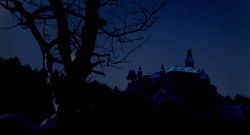
The indoor scenes play out in the recreated castle: The introduction of the childhood Erzsébet Báthory and Ferenc Nadásdy, their political marriage, lavish parties, and even a young Countess playing the harpsichord. There is no intimation of torture; the famous story of the thief sewn into the horse's belly is nowhere to be found. Inside and outside the castle, all is magical with war and horror far away in mind and geography. No locations are given in the film's credits, but some of the angles and the church appear to be Cachtice, abeit all likely purpose-built for the production. There are occasional shots of what may be the true village of Cachtice (from my memory); other sites, such as Sárvár, are well-preserved and used for location shots.
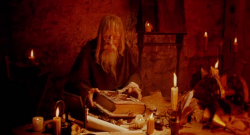
The fictional Friar Peter pens the story he is narrating into a thick volume, writing backwards ŕ la DaVinci. The film then presents the tale as the three dragon teeth in the Báthory family crest. The first tooth is Part I: Ferenc beginning in 1593.
Part I: Ferenc
The film falters almost immediately. Anna Friel is a beautiful Erzsébet, but throughout she seemed like an actress playing the Countess rather than inhabiting her persona. Famke Janssen was originally slated to play the lead role, but withdrew for unexplained reasons; the script, which washes the solidity out of Erzsébet, would have been good enough reason. Though she is missed in the lead, giving her talents to another film on the Countess would still be welcome.
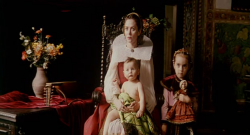
More significant than Friel's role, though, is the introduction of 'Merisi' -- a Venetian painter who we later learn is the yet-to-be-famous Merisi de Caravaggio. For Jakubisko to create this fiction with a character who never visited the Hungary of Erzsébet is to use a fairy tale to uncover truth. And it is indeed a fairy tale, beginning with Caravaggio plundering flowers from the nearby gardens for his paints -- especially the blue in his Venetian rose. The handsome Hans Matheson plays the role well, but turning the story of the Countess into a soap-opera-style love story is an absurdity. More on the significance of this failure later.
The second forced failure are the monks -- one of whom is narrator and scribe Peter -- who are sent to spy on the castle under the guise of mapping Upper Hungary for the bishopric. They bring clever devices which are intended to suggest the Renaissance and its inventions: Outsized roller skates; shoes with wound mainsprings that plow uphill, carrying the monks along; flasks of liquid in a frame that create a primitive camera; powerful lenses for surveying. Like clowns in a Shakespeare play, they carry no weight despite their critical role inside the story and its future history.

Back to Erzsébet: She prances around on Ferenc's back brandishing a sword yet looks like a harried housewife when he later shows up. He rapes her and she loses her unborn son in a scene of trivial devastation. There can only be a "fer gosh sakes!" reaction to the shallow despair on display. Meanwhile, in battle with Ferenc, Count Thurzó (clearly the villain because he is not called by his given name György) shows his envy of Ferenc's beautiful wife. Cards are played (with an anachronistic deck) as well as chess. And in the other meanwhile, Caravaggio -- also attracted to the Countess -- sleeps with servant Erika, nearly caught with her by Erzsébet in a who-me? scene where he claims to be mixing red paints ("blood, life, love"). Dorattya, brilliantly played by Deana Jakubisková-Horváthová, is suspicious of Caravaggio.
Caravaggio wants Erzsébet and performs the "I need a nude model" pickup line, at which point he's bitten by an Ursini's viper and taken to a castle basement where Erzsébet cauterizes the wound and cures him with medicinal herbs ... carefully drawn and painted in a book that also includes plants and flowers. Though this suggests Erzsébet's intelligence, Jakubisko throws it away and moves to an outdoor scene where "Thurzó's deer" graze in the fields and the carriage emblazoned with the dragon teeth carries the Countess and her Venetian artist to the accompaniment of music; somehow the deer ignore the musical racket and even the clattering cart, allowing Erzsébet to easily shoot one at long range. Caravaggio gains her confidence; she takes him to see her baby -- the dead one, preserved in a block of ice -- to be painted by the artist in a single night.
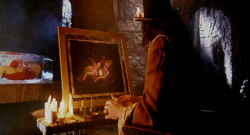
If the film seems to border on the absurd, it does. Wearing a hat of candles, he paints into the dark night and (you can see it coming) disturbed by intruders, he allows his candles to catch the oil paints on fire and the work is ruined. The scene brings nothing whatsoever to the film's plot or direction. They travel again, watching young women being burned at the stake while monks stand by singing; the Countess orders Caravaggio to undress and leaves him behind to chase the carriage.
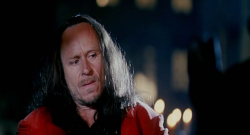
Having wasted several scenes and the viewer's attention, Jakubisko finally gets down to business: On her visit to another castle, she sees the portrait of (the invented) Anika Báthory, always young and beautiful and carrying the same birthmark as Erzsébet, who burned down her own castle in suicide. At the following sumptuous party -- here Jakubisko shows his artistic skills, painting such scenes handsomely -- Caravaggio sketches as dancers whirl and musicians play and sing. Thurzó is there and while playing outdoor chess with the Countess on a grass board of great stone pieces, he suggests an alliance in place of rivalry. He is spurned and the Countess wins the match (with Caravaggio moving the last piece and knocking over his king).
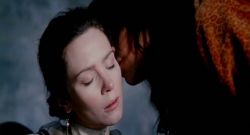
This much detail in a review is unusual, but with the film being such an interlocking puzzle of the marvelous and the wretched, no summary will do. That said, it is at this point that the story could turn to Erzsébet's political skill, her character as a polyglot, her extensive bringing-up of (at least) her son Pál, a deeper look at her medicinal skills, perhaps even the introduction of Klara, who merits nary a mention in this telling of her life story. Instead, she abruptly returns home to tend to her injured husband, whips the maids because the bedroom had not been tidied up (yes, "tidied up"), and falls exhausted into a chair where, indeed, Caravaggio appears and she orders him to kiss her. She disrobes at last so he can paint her, with pillow-talk about sex (again) and of Aunt Anika's birthmark, paintings, and immortality via painting. It all devolves into there being "something wrong with my blood". A black cat comes and goes.
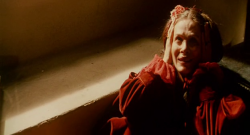
It shortly becomes clear that Jakubisko has no respect whatsoever for Erzsébet. He turns her into a plaything with outbursts, and the pawn in Thurzó's chess game. He tarts up a death -- an old man from puncture wounds that look like vampire bites but came merely from a knife Erzsébet gave to a servant for her protection (she did? she would?) -- and then gives the body to Caravaggio, who had proclaimed his need to understand the human form. Get ready. "It feels like murder," he says as the knife hovers over the lifeless body. "Let's murder together," she replies with a smile -- a fragment of conversation seen and heard from the window by Erika, who later calls for Merisi/Caravaggio to run away with her. He gives her Erzsébet's ring which the Countess later sees on her hand. Whipping and falling-from-window follow, which (naturally) other servants see as Erzsébet looks out the same window. She begs forgiveness from God (cue dreadful musical underscore) and sees her betrayal by the artist. Piling on are accusations of lying, cannot-live-without-yous, soap-opera acting, and the unexpected return of (naturally again) Ferenc.
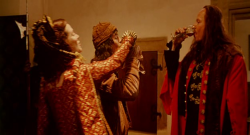
Whew. But Jakubisko isn't done. There's another party. Ferenc and Thurzó talk. Erzsébet gets drunk. Thurzó takes the advantage and tells Ferenc that his wife and the artist spent a night together at Sárvár. But Thurzó will take care of it for Ferenc with some poison. Caravaggio takes the glass but a drunken Erzsébet runs over to snatch it from his hand and drink it down. She is poisoned. He sends for Darvulia, the witch, and has Caravaggio walled in to die.
So ends Part I, misnamed "Ferenc" when it was really about Caravaggio.
Part II: Darvulia

In this copy, the title frame for Part II is missing, but the transition suggests it begins upon the appearance of Darvulia's face hovering over Erzsébet as she cures her; Dorattya is nearby to protect her and once again outshines the other characters in the minor role as the Countess's handmaiden.
Darvulia's herbs and suction glasses indeed remove the poison, but at the same time Darvulia claims she can keep the Countess young -- if she will sacrifice both love (overwrought pause) and her reputation. Under Darvulia's spell she raises her arms in a sadly funny imitation of Lugosi's famous Dracula. She is enslaved by Darvulia. And Caravaggio (not forgotten) has somehow escaped from the walled-in chamber. Erzsébet's regret? That he didn't bother to say goodbye.
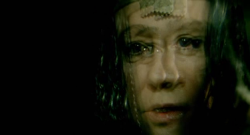
Meanwhile (there is always a kind of 'meanwhile' aspect of Bathory), the monks engage in a rivalry with the new Pastor Ponikenusz (Ponicky in this film). Charged with investigation, they hurry off on their rollerskates to see a servant killed in a kitchen argument (supposedly caused by one of Darvulia's spells), reporting by carrier pigeon to Cardinal Forgács that "mutilated bodies" are being buried in the garden.
Jakubisko promptly turns up the religious heat. Protestants and Catholics lay waste to each other, with villages burning and Peter continuing to document it all, writing backwards in his journal. After his report to the Cardinal, he is ordered to see if Darvulia is making Erzsébet evil. People die in arguments, Darvulia casts spells, glasses break, bodies turn up. It is not looking good for Erzsébet already, who has been spied bathing in a blood-red bath. Shortly before, during the seige of Buda, Ferenc is abandoned by Thurzó, who has gone to chase some Ottoman slaves with chests of gold and treasure. Shells explode and Ferenc is mortally wounded. Candles blow out in Cachtice. Darvulia sees death. Ferenc returns, making his wife promise to marry Pál into the Batthyány family for his protection. As a black bay rises and rears, Ferenc dies.
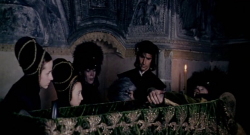
The funeral is once again Jakubisko and his costume and set decoration crew at their best. The colors are somber, rich and varied -- grey on grey, brown on brown, even black on black -- and the film takes a serious and historical turn ... at least until Thurzó approaches Erzsébet over Ferenc's casket to demand a portion about the land. A fight ensues (religion on religion), and cousin Gábor pledges to protect her against Thurzó. As an afterthought he hands her a letter with a blue seal. She opens it and, having not once expressed regret at her husband's death, brightens when she reads it. "Caravaggio! He's alive!"
More dead servants show up. Erzsébet dreams of making love to Caravaggio when the dream switches to Anika, who died in flames by her own hand. The future? We need not wonder; Jakubisko has no craft in matters of plot tension. Meetings with Thurzó are fruitless; he clearly wants both her land and her, despite his claim of "representing the king's interests here."
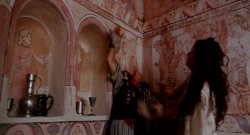
But something has gone wrong with the Countess, whether from the poison or Darvulia. Nicked while having her hair cut (a part of the Erzsébet fiction that Jakubisko now adopts), she takes the scissors and kills the servant, all in front of jongleurs and their wonderful braguettes and false penises. She has hallucinations. More unexplained bodies turn up on the streets of Cachtice, and Ponicky sermonizes about the evil Countess "bathing in the blood of innocent virgins". The monks begin to wonder, thinking she looks too young, and set out in spring-loaded mechanical showshoes up the hill where they are showered with blood tossed over the wall -- from, it turns out, an animal being slaughtered. Darvulia, meanwhile, is frightened for the Countess and discovers hallucinogenic mushrooms in the potions. They argue about blood. "Look what this mushroom has made of you," Darvulia excoriates. "A murderess!" Erzsébet has Darvulia locked away by Ficzko ... not the Ficzko of history who is small and deformed, but Jakubisko's Ficzko, tall and loyal and strong and dark-haired.
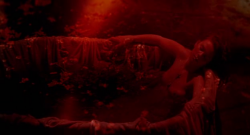
The monks manage to sneak into the incredibly well fortified Cséjthe castle on the hill with equipment to photograph her. Yes, another invention appears, made from flasks of liquid and focusing on a screen. The Countess is bathing in blood, it appears. The monks are seen! Havoc ensues! But from the wounds on his back as he is about to be whipped, Erzsébet sees that the younger monk is Cyril, a boy rescued from wolves and cured by her medicinal skills. Cyril takes advantage of the good will to dip a flask into the blood -- which turns out to be a tub of red herbs. And Darvulia has escaped, her chains cut. The monks are sent away. Friel lapses into an abominable crazed Erzsébet.
"The more plentiful the legends, the fewer the facts," Peter repeats now in his role as narrator. "There were no vampires nor bathing in blood." Cardinal Forgács's spy wants to know who is behind "these strange events." Then Erzsébet discovers a chess piece -- a king -- and whispers hoarsely, "Thurzó!". Yes, Thurzó. The herbs book, stolen by Darvulia, shows up at a party at Thurzó's. As does Darvulia herself, missing a tongue.

From these events the previously crazed Countess recovers promptly and sets out to hear a brightly staged work-in-progress Orfeo by Monteverdi in Vienna (Jakubisko missing the clever opportunity to use the Christian-Muslim conflict epic The Battle of Tancredi and Clorinda, even if it was written 24 years after Erzsébet's death). And who should appear? Yes, the escaped Caravaggio. She leaves the opera to see his lastest masterpiece. They kiss again. And in another tip of the hat to the absurd, they make love in a confessional, with her gown's train stuck in the door as the solid wood structure sails slowly across the marble floor and crossfades to Viennese canals in Renaissance colors. He gives her a Venetian blue ring. The masked ball goes on and on.

Thurzó invites Erzsébet to meet the new King Matthias. In front of the king, the fortune teller at the ball informs the Countess and the surrounding court that she has conspired with the devil, but it is clear that Thurzó and his wife are doing the prompting. Matthias is kind but Thurzó believes the king supports him in his quest to be a stronger ruler. Erzsébet is mysteriously drugged, dragged to a bath, maids killed, and blood to be poured in -- evidence against the Countess when the witnesses from the nobility are called in. But she escapes, foiling the Count's plans, and her carriage brings her and Darvulia (taken from Thurzó) back to Cachtice. Darvulia dies and, as promised, leaves the name of the evil person on the stone wall in her own blood. It is no surprise: Thurzó.
Family arguments follow. Everything will go to Pál. The sons-in-law are disaffected.
Part III: Thurzo

Thurzó's assassins -- the same brawny fools who couldn't keep a small and drugged woman confined to a bath -- fail to kill Pál, so the Countess in motherly fury beheads them both. More village burning follows, this time by Erzsébet's minions ravaging Thurzó's protectorate. Gábor promises to send an army if needed, but also brings word that Caravaggio has died of a fever. In despair she cuts out her head from the Venetian's painting and burns it, recalling Merisi saying, "A painting can preserve what time destroys." Time is running out for Erzsébet. Thurzó reacts to Erzsébet's attack on his villages, setting in motion a plot to kill servants in broad daylight from a carriage with the Báthory coat of arms on it -- and in front of the monks, so they might report it. They do so, followed by more stupid monk tricks, including young Brother Cyril kissing the nearby servant girl. Their time is running out as well, and run out they plan to do.
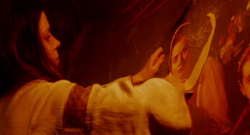
Thurzó and his henchmen begin to get signed testimony against the Countess; the turncoat sons-in-law join the plot, while at Cachtice, Erzsébet gives Pál a coming-of-age protector lecture and blessing. The monks come to warn her before departing, and she prepares a carrier-pigeon letter. During the entire film, every carrier pigeon has flown through to its destination -- but not this time. It is shot down by Thurzó's men. Erzsébet gives Caravaggio's Venetian blue ring to monk Peter. She frees Lucia and her family from service, and takes one last herb bath.
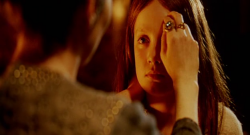
Jakubisko rolls the film toward the climax, with girls kidnapped and then freed by the monks, Ficzko setting dogs on attackers, and the internal spy turning out to be Dorattya. The black cat appears again, and Thurzó shows up at the castle to arrest Erzsébet. Marvelous swordfights ensue, with the power held by Thurzó and then Erzsébet and then Thurzó again. An image given years before by Darvulia comes to pass. Erzsébet is taken. She is a prisoner. Bodies are pulled out of graves. Chests of jewels are taken and counted. Ponicky is vindicated. Townspeople sign the book of accusations. The monk Peter sends his last dispatch and leaves the high castle wall -- by parachute. Lucia is tortured and killed. The conspirators -- Dorattya and two other servants, plus Ficzko -- are tried, sent to be mutilated (Ficzko gloriously beheaded with a head spilling innards on camera), burned and hanged on the wheel.
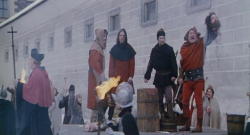
Erzsébet is sentenced to her legendary lifetime imprisonment in the "Black Tower"
King Matthias is unconvinced, asking Thurzó for real witnesses. Thurzó goes to Cardinal Forgács, and a deal is struck -- Forgács has gotten the monks' pigeon-mail, and will trade testimony for the chests of treasure. Monk Peter writes his journal -- this time normally, not backwards.
Epilog
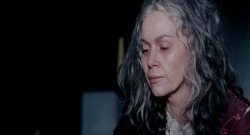
The year is 1614. Peter shows up as a mendicant monk at the Black Tower, using the Venetian blue ring to identify himself. He reports Gábor is dead, with Thurzó behind it. (So many continuity issues distract in this film; here the torch that lights the candles goes from large to small.) She gives her will to Peter and then falls into Jakubisko's place: "I was born at a time that was not right for me. I am not as strong as I thought." Peter leaves and she lets the candles burn the paintings and dies in the flames as did her birthmark-mated Aunt Anika.
Thurzó confronts Ponicky one last time. "I loved her."
Commentary
For those who have followed the story of Erzsébet Báthory, this film by Juraj Jakubisko is important -- not only because it seriously treats the Báthory legend but also because its budget was significant enough to do a thorough job with history. The invention of the Peter and Caravaggio turned history into a paltry love story, and reduced Erzsébet to a metaphor for weakness.
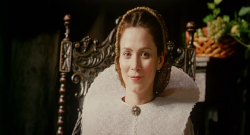
First, the minor points. The battle scenes are not central to the plot; they are gratuitous. Chasing Ottoman harlots into a trap has no meaning to her story. The villages on fire simply look like a movie set and are unconvincing. The deaths are likewise without substance; only the dead bodies themselves are good, startling, mystical. The missing Aunt Klara is problematic. The original portrait is blotted out (save for a live posed shot at the very end), and just one with the children that she cuts her head out of is featured. Darvulia is old, a witch, a cliché and as good as Deana Horváthová is with the role, she has nothing to work with in the director's script. The children, so important in all works about the Countess, have almost no role at all; even Pál is little more than a prop. The English -- the language in which the film was shot -- is outright bad, with lines like "the only way to nail her is to catch her in flagrante delicto" and lots of "bitch" tossed around. The Renaissance 'inventions' of the monks are just absurd. The music composed by Jan Jirásek, Simon Boswell, and Maok is an odd collection of pseudo-historical elements and threaded with a totally videogame modern thumping. And the old Erzsébet has signs of age but not of three years in the cold tower -- she is not dirty, not bug-infested, and exhibits nothing of isolation but some fake grey hair.
More important than any of these quibbles is the treatment of the title character. Jakubisko has taken away her power. He has made her weak. No, not because he has taken her from being a killer. Rather, he allowed someone who is a mere artisan (an encounter invented for the purpose, Caravaggio) to become the emotional focus of the tale, he allowed her to be a suicide (even if Thurzó considered it a "checkmate"), and he allowed the narrator to frame her emotional actions by saying "desperate wailing and sobbing could be heard night after night".
Moreover, an artist? Where were the scientists she had at table? What happend to her skilled negotiations -- all we hear is that she will sign a document "for Ferenc". There's the dead dog (blood, where the legend begins) which makes her vomit. He never intimates her linguistic fluidity, nor the reason the others respected and even feared her, this woman more powerful than legions of men. Jakubisko himself is afraid to admit her power.
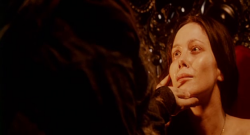
What Jakubisko has done in this luscious film is to launder Báthory, to turn her red garments white, and in the process strip away the very characteristics that have made her a fascination and even an icon or obsession for many young women in modern times. Intelligence is replaced by sexuality; political power is replaced by court intrigue; the conquests of Ferenc replace the negotiations of Erzsébet. Even if Jakubisko's thesis of Erzsébet's innocence is true, by re-casting her as a woman in little more than a love story he denies the power and strength that kept her alive and well for so long while the Habsburg and Ottoman Empires faced her from either side. Absurdly, she is even denied her bisexuality (while, perversely, Caravaggio is allowed it!).
Her very affair -- central pivot to the plot -- is no more or less sordid than those of the Venetian with servant Erika, also painted by Caravaggio. Scene by scene, Jakubisko turns Erzsébet into a powerless, simpering victim -- of Ferenc, of Darvulia, of Thurzó, of love and death themselves. She is never portrayed as the woman whose skills -- even were the 600 murders merely legend -- could resonate through the centuries. In a way, Jakubisko redeems his slain forebears by taking vengeance on Erzébet through cinema.
This is a sumptuous film. It must be seen. But what the director has done cannot be easily dismissed as a mere re-setting of the historical tableau.
Reviewed by Dennis Báthory-Kitsz, April 28, 2010



























